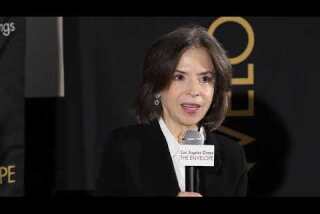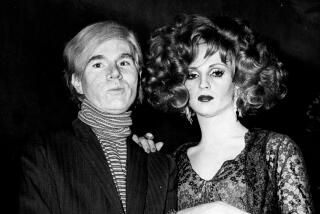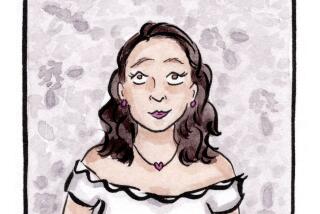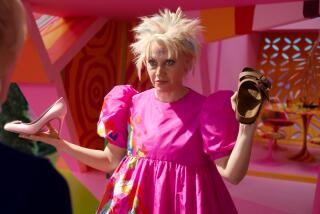The Envelope: The real-life artists of ‘The Danish Girl’ inspire a costume designer’s creations
Movies don’t often require costume designers to dress men as women, except for perhaps a campy drag scene. In “The Danish Girl,” costume designer Paco Delgado created clothes that had to sensitively portray a man beginning to understand his gender identity as a woman.
Eddie Redmayne plays the real-life transsexual pioneer Danish painter Einar Wegener, who became Lili Elbe in the early 20th century. As a successful landscape artist, Wegener lived a fairly conventional life with his wife, Gerda, a fellow artist played by Alicia Vikander. The film, directed by Tom Hooper, follows Wegener as he gradually and sometimes awkwardly incorporates his new identity into his thoughts, movements and attire. Clothing frequently triggers action.
SIGN UP for the free Gold Standard newsletter >>
Delgado had several written accounts to guide him, including the 1933 “Man Into Woman: The First Sex Change,” and the fictionalized version published in 2000, “The Danish Girl” by David Ebershoff. He also studied Gerda’s artwork, particularly her many paintings and fashion illustrations of Einar as Lili. Here, Delgado shared the thinking behind his designs.
Watch Q&As with the ‘Danish Girl’ cast and crew


'Danish Girl': Seeing Eddie Redmayne as Lili Elbe

'Danish Girl': How Alicia Vikander learned to paint

'Danish Girl': Who was the real Gerda Wegener?

'Danish Girl': Looking back at the film's long journey to being made

'Danish Girl': Fashioning the costumes and set design
Did you copy any dresses exactly from Gerda’s paintings?
There is one dress we copied 100% — though we still had to imagine it. That is in the scene where Gerda is painting a portrait of one of their friends, Ulla, a dancer at the Royal Danish Ballet. That is the dress that Einar models for Gerda [when Ulla isn’t available], and then realizes who he really is.
This is a story about painters. Did you in turn “paint” them into the movie frame?
We tried to follow their paintings as an artistic guide. If you see what they are creating in Denmark, and later in Paris, that is definitely reflected in the colors in their costumes. Everything in Paris is much more happy, delightful.
When they are in Denmark, we dressed them ... basically in different shades of blues and grays and blacks, in a palette of very soft colors. If you see the early Einar paintings and Gerda’s, they were very restrained and boring in a way. We tried to show that same kind of restraint.
When they left to Paris, their palette, especially Gerda’s, opened quite a lot. She started to do many illustrations for Vogue and became a very successful fashion illustrator. All of her drawings and paintings of the period were really jolly with a lot of sexuality in them, with more warm colors. That is what we tried to do with the costumes, bring the energy of what was probably the happiest moment of their lives.
Was Eddie Redmayne’s physique altered with pads, shapers or other devices to effect a feminine form?
From the beginning, the only thing we did was make a corset for Eddie to show a difference of shape, but we didn’t add any hip or chest padding. What [change] you see is made mainly with the cut, the silhouette and through applications of design elements [such as] fabrics on the chest area to create a little more volume or pleats in the hips to add more shape. We didn’t alter the body itself. We tried in a way to mimic what Lily would have done. She didn’t have any plastic surgery to create a more silhouetted body. She was being herself.
MORE: Get our best stories in your Facebook feed >>
Fashion of that era aspired to the gamine ideal, which must have allowed some interesting opportunities for you, yes?
A lot of the movie took place in the ‘20s, and the silhouette of the ‘20s was a flat-chested woman with almost no hips. That worked to our advantage. I read that Lili was a muse of the ‘20s. I don’t believe that she might have been so influential, but Lili was a very famous character of the period. She and Gerda were social and attended a lot of parties. And Gerda was very connected to the fashion industry, doing a lot of illustrations for fashion periodicals.
Do you have a favorite costume in the movie?
The suit in the cream color with the lavender scarf. It was a pivotal dressing moment when you see perfectly that transition. It shows that confusion — is it a man’s suit with a lot of women’s ideas, or is it a woman’s suit with a lot of men’s ideas? You can see the journey Lili was having. You can see the progression.
More to Read
From the Oscars to the Emmys.
Get the Envelope newsletter for exclusive awards season coverage, behind-the-scenes stories from the Envelope podcast and columnist Glenn Whipp’s must-read analysis.
You may occasionally receive promotional content from the Los Angeles Times.






